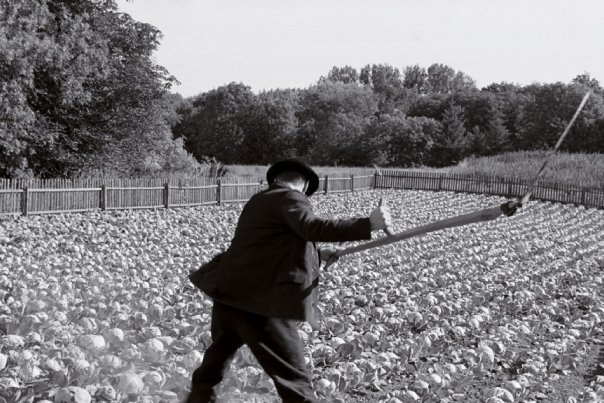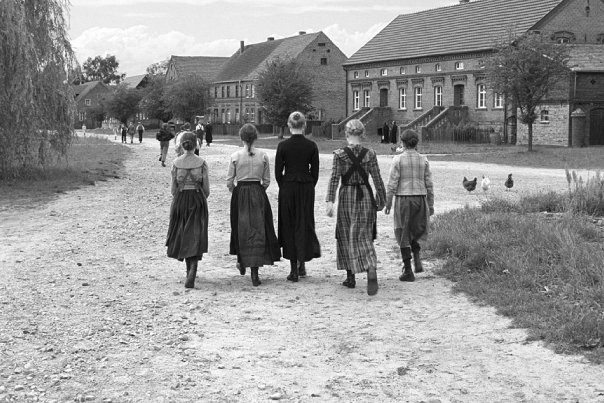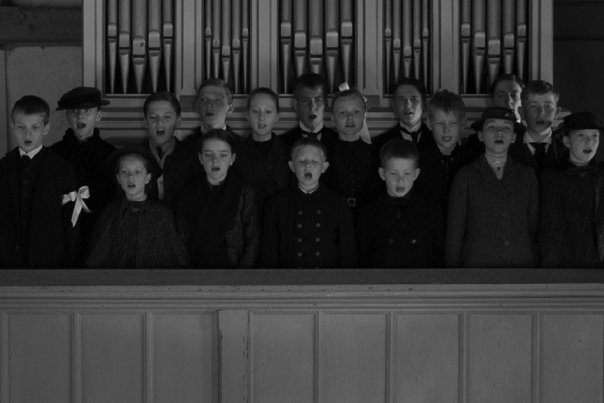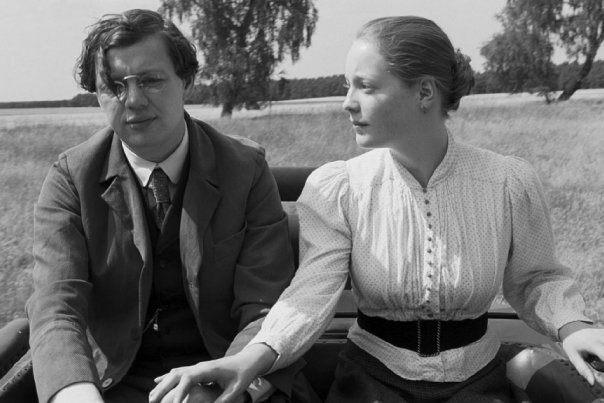Michael Haneke’s career is one of thoughtful provocation through observation. His form of commentary is an oblique one, the true motives of which are arrived not so much by what is on screen, but by the audience’s reaction to it. His most famous film, ‘Funny Games’, is an exercise in the morality of violence as depicted on film. In place of saying that it desensitizes the audience’s moral reaction to real violence, Haneke attempts to force the audience into being conscious of enjoying the violence on screen, forcing us to deal with the violence we so casually consume on a regular basis. Unless one walks out of the film, one is forced into the confidence of the sadistic protagonist. Stanley Kubrick took on a similar challenge with ‘A Clockwork Orange’, with questionable results, and Haneke is no Kubrick. His attempts at forcing a reaction from the audience are fascinating, but more interesting in concept than in practice. As a piece of social observation, ‘The White Ribbon’ is not uniquely incisive or relevant to today; yet it is a powerful and haunting film, a horror film about a community rotten in its core.
The film brings to mind a number of different films, of different genres. It is set in a small German village in 1913, where strange and troubling things are occurring. Like ‘Village of the Damned’, the children of the village are grim and angel-faced, with ghostly complexions and striking eyes, and are possibly involved in the disturbing acts. They are often the center of the scene, and can often be found in groups, suspiciously feigning ignorance when approached by adults.
Somewhat less concretely, I was reminded of Tim Burton’s terrific film version of ‘The Legend of Sleepy Hollow’. That film is about series of troubling events in a small town domineered by five authority figures (aristocrat, magistrate, lawyer, doctor and priest) concealing a big secret, shown largely through the prism of one outsider (I say film because the original story is differently structured). In ‘The White Ribbon’, the town is represented by the Baron, the Doctor, the Steward and the Pastor as well as their wives and children. Our outsider is the town’s school teacher (Christian Friedel), who is not a native of the town (and could be Jewish, though there is nothing explicit about Jews or Judaism in the film).
Probably more germane is its resonance with Henri-Georges Clouzot’s 1943 film ‘Le Corbeau’ (‘The Raven), about a small town shaken to its core by the circulation of anonymous letters uncovering secrets of the townspeople. The film was a direct reaction to the times- made in occupied France; it is aimed at the destructiveness of collaboration with the Nazis. The film bridges the gap between the tonally resonant provincial horror tale and the film most thematically resonant with ‘The White Ribbon’- the classic ‘M.’, by Fritz Lang. Made in Germany in 1931, Lang’s film, like Clouzot’s, is a clear reflection of the mood it was made in. Under the veneer of a thriller –the hunt for a child-murder in Düsseldorf- Lang presents a scathing portrait of the German people at that time. Though undeniably vile, the murderer is a tortured soul, driven by uncontrollable impulses. Even with his evil deeds, he is granted the filmmaker’s sympathy for being helpless and pathetic, and for being torn by his acts, which he knows are evil. Not spared are the civilians looking for him. We see this society fall into chaos and violence, where this one person’s crimes act as impetus for civilians to be ravenous beasts, anxious for blood (the fact that Peter Lorre, the actor that plays the murderer, is Jewish, only adds to this). The film shows a disgust with this society and ends with one woman saying to herself and to the audience “One has to keep closer watch over the children. All of you”.
Haneke is not nearly as direct, but he similarly observes a community with a rotten core falling apart, and the ramifications it has for the children. Set right at the cusp of World War I, the story is obviously analogous to Europe at the time- materially subservient to and dependant upon the unnecessary and unjust Baron, spiritually guided by the cold, unmerciful priest. The oppressiveness of these symbolic figures –not given names, explicitly calling attention to their allegorical nature – permeates just about every aspect of the town, especially the younger generation, whose corruption will culminate in the creation of Nazism.
The power of the film is the fact that though the parable is so easily summarized and easily understood, it doesn’t play like a parable. Only as the movie ends did I realize how effective it is in its storytelling. For much of its run time, it feels like an episodic and meandering tale of this destructive community, given shape by the mystery of who is responsible for the violent acts. But by the time the solution seems like it might be presenting itself, I didn’t really care. To mix and match two Hitchcockian concepts- Haneke tells us that there is a bomb under the table, waiting to explode. By the end, the bomb is harmful enough before it goes off- the explosion itself is a MacGuffin. There are obvious suspects at the end, but they are not the real perpetrators. The whole rotting town is responsible, including some of the victims.
The film is indelible in its power- it evolves gradually, yet inevitably. Even though it is at times almost unbearably grim, it burrows in and festers, like an evolving virus. I do not mean that as a slight- Haneke’s vision is unflinching and complete enough that the film gains some of the insidious power of the ugliness it presents. It is shot in haunted and beautiful black and white, but without a great deal of contrast –the black bleeds into the white, visually creating a world with darkness always encroaching on light.
And there is very little light that is not encroached upon. All of the town leaders are at first presented not unkindly, but don’t take long to reveal ugliness. The Pastor is first seen seemingly worried about his children missing dinner, which very quickly transforms into anger at being disobeyed and disrespected. Their punishment is being lashed, and being forced to wear the white ribbon of the title. The ribbon is supposed to remind them of purity, an image which is perverted when the son ties it to his arm, very much resembling a Nazi armband. Likewise, initially there is nothing about the town’s doctor that implies a cruel temperament. He is, after all, the very first victim of the crimes, violently falling from his horse, after the horse is tripped by a near invisible wire stretched between two trees. On top of that, he is a widower who leaves the hospital early to comfort his young son. Yet he has the darkest secret of all, as well as the film’s single most devastating scene, a painfully cruel series of humiliation he unleashes on his mistress.
With all of these, the undeniable discomfort in watching this film is tempered, ever so slightly, by smidgens of warmth- a child offering a gift to a parent to replace a (symbolically) destroyed possession, or a father ignoring his natural rigidity and following his generally dormant fatherly impulses. One of its best scenes is one in which a girl attempts to explain death to her young brother- not exactly a barrel of laughs, but a relatable and heartfelt scene that is untouched by the oppressive machinations outside.
Most importantly, there is the love story, between the Schoolteacher and a nanny at the Baron’s house. This love story is presented in an unadorned and straight-forward manner, and is the total opposite of the pervasive ugliness of so much of the film. It sticks out like a sore thumb, yet that incongruity is precisely what makes it effective. In the midst of the oppressiveness, I took the fact that this sweet love story is forced in to be a sign that Haneke felt the need to show an example of simple, good people in the world. As corny and blunt as that sounds, it is comforting to think that the director went out of his way to show kindness. It won’t help the children, but at least there is something unsullied in this town.
In closing, though Haneke would disagree, I do not think that ‘The White Ribbon’ works as an observation on a relevant and current issue. Inasmuch as it has to say about education, and the effects on children of both nature and nurture, it is hardly groundbreaking. What it was for me is an interesting parable, filled in to make for a fascinating presentation. Yes, it is a roots of Nazism allegory, but turned into an imposing and nerve-wracking tale, horrifying and bracing, painful and unforgettable.
SHLOMO PORATH











This is a brilliant must-see film. The name “Das weisse Band” strikes me a we bit stronger than the English & Hebrew titles “The White Ribbons”. It is refreshing to experience an instantly classic art film that is both rich in its austerity and masterful in its compelling tension. Where did 145 minutes go? The haunting evil resonance is so captivating and powerful that only half through the film do you realize the B&W format; Technicolor be banished. Hooray for Michael Haneke for granting us such unforgettable drama, imagery, characters, socio-economic-religious-historical dynamic interaction. He deserved to win the Oscar. So don’t miss it on the big screen otherwise its slow pace will have you scrambling to the fridge for comfort food and that would be a shame on multiple levels.
Comments are closed.